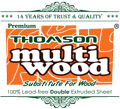deforestation
environment
environment-friendly
global warming
Multiwood
Multiwood Promos
PAPER
pine trees
Save Trees
trees
vegetarian
Water conservation
News
Disadvantages of Plywood

Jan 11, 2012
While plywood is a versatile, strong, and durable material, it is not without disadvantages. Plywood is subject to a variety of problems, both from its unsuitability for certain purposes and from environmental hazards. Used incorrectly, plywood can rapidly fail. Even when used within the manufacturer’s specifications, plywood can and will fail eventually.
Size
Plywood is available “off the shelf” almost exclusively in unwieldy 4-foot-by-8-foot sheets. Plywood comes in a variety of thicknesses, but the only means of changing the thickness to suit a particular need is by gluing sheets together. Plywood cannot be made thinner by surfacing, as can be done with lumber. Attempting to do so will severely damage the plywood. Plywood can be custom-ordered in the same size and shape as other lumber if desired, but the expense is prohibitive.
Geography
Plywood is more susceptible to moisture and weather damage than regular lumber. Unless specifically rated for exterior use, plywood will fail in the presence of moisture. Even exterior plywood must be coated or sealed to endure weathering. The coating or sealing must be regularly maintained to prevent failure. Marine-grade plywood is designed for boat sub-floors and other areas where moisture is frequently encountered, but the expense of such plywood precludes its use for other purposes. Also, in time, even marine-grade plywood will fail due to weathering.
Function
Plywood is created by stacking alternating layers of thinly sliced wood and securing them with an adhesive. Because of the method used to construct plywood, it is stronger than most types of equally sized and shaped lumber. Unfortunately, this construction method also makes plywood easily damaged by exposure to water. The thin layers of wood readily absorb water and, through capillary action, draw the water deep into the wood. This compromise the integrity of both the wood and the adhesive used to hold the layers together.
Effects
The effects of plywood failure can be catastrophic. Plywood is frequently used as a sheathing material for shingle roofing. When plywood used for this purpose fails, it doesn’t usually come to the owner’s attention until the roof begins to leak. Closer inspection usually reveals that the plywood had begun to fail long before, and only became evident when the failure was so pronounced that there was no alternative but to remove and replace the entire sheet. Plywood used in flooring also suffers from weathering, such as that caused by dampness under the house or flooding severe enough to soak the plywood.
Considerations
A number of plywood products have been introduced to replace standard lumber, such as laminated studs. These studs use an “I-beam” construction, with nailing strips on the edges, and a thin piece of plywood is used to hold the nailing edges apart. Laminated studs are sometimes more affordable than standard 2″x4″ lumber and are considerably stronger, so long as they are kept dry. In a humid environment, however, this is nearly impossible.





 Chat Now
Chat Now